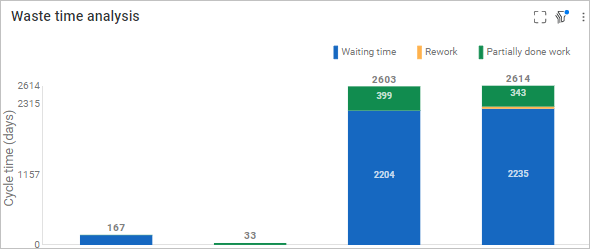Waste management
You can track waste time for work and quality items.
Overview
You can track waste time for the following items:
- Work items: Features, epics, stories, and defects
- Quality items: Manual, Gherkin, and MBT tests; manual test runs and test suite runs; BDD scenarios
You can analyze the scope of waste per item, release, or team.
The following sections describe how to define waste and enable waste tracking.
Define waste
You can define waste with the help of waste categories. Waste definition depends on the methodology adopted by your team, and can include: waiting, overproduction, transportation, over-processing, inventory, unnecessary motions, or defects.
The following waste categories are predefined.
| Category | Details |
|---|---|
| Waiting time |
Associate with phases that imply waiting for a certain team to start working on an item, for example Ready for QA. Tip: You can create a separate Waiting time category for every team assigned to an item. This will help identify bottlenecks in a release workflow. |
| Overprocessing | Associate with phases that may involve multiple changes to an item design before the work on the item starts. |
| Rework | Associate with phases during which the team effort was invested in unnecessary tasks. There may be different reasons for a rework, such as a wrong design or requirements misunderstanding. |
| Partially done work | Associate with phases that were repeated, for example due to incomplete or low quality work. |
Note:
- You can create additional waste categories to comply with your methodology.
- You can deactivate or deprecate any of the waste categories. Click the ellipsis
 to the right of the category row.
to the right of the category row. - You can't deactivate or deprecate the default waste category None.
Enable waste tracking
Waste tracking is based on an item's phases or certain conditions that are associated with waste. Depending on an item's phase or condition, the business rule associates the item with a specific category from the Waste category list. The decision whether to track waste is then decided based on the item waste category.
For work items, you can track waste time for items in the In Progress,
For details on the item workflow, see Workflow.
To enable waste tracking:
| Step | Details |
|---|---|
| Define waste categories |
Use any of the predefined categories from the Waste Category list, or create new categories. For details, see Lists. The categories are further specified in business rules, and help identify where the item time is wasted. Default category: None. An item is associated with the None category when the item's phase is not associated with any of the waste categories specified in the business rule. |
| Design business rules |
Business rules help monitor an item's transition between phases associated with waste, and trigger waste tracking. When designing business rules, consider the following:
Example:
Item no longer meets the business rule condition When an item no longer meets the business rule condition, the item waste category is automatically set to None, and waste tracking for that item stops. Note: If no phase or condition is specified in an item's business rule, the item is associated with the default None category. You can also create a business rule to associate a work item's repeated phase with waste. Available for work items only, not for quality items. Example: If you move back to the In Progress phase, associate the repeated phase with the Rework waste category as follows:
When this business rule is turned on, the repeated In Progress phase will be associated with the Rework waste category. For details, see Design business rules. |
Waste time tracking widgets
The Dashboard allows you to view graphs representing waste time.
The ability to track waste by categories allows you to identify the primary cause of waste in the value delivery flow. It also helps you understand where to invest efforts in order to eliminate waste and maximize the efficiency of the value flow.
The Value Stream Management Waste time analysis widget shows the wasted time per release. The graph's stacked bars show the waste time broken down by the relevant categories, such as waiting time, reworked items, blocking defects, and partially completed items.

Tip: The default widget shows waste per release. You can modify the configuration to have the graph show waste days for other entities such as milestone, sprint, team, area, or custom dates.
 See also:
See also:










